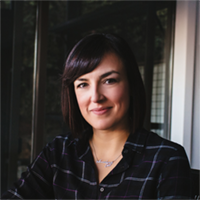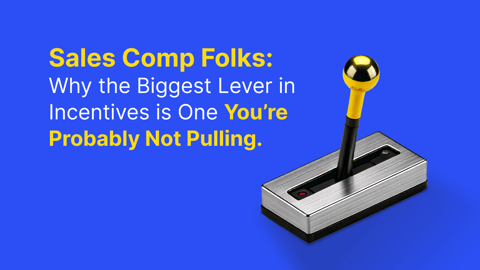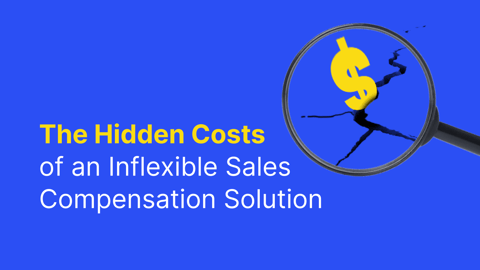This is part of a series of interviews with B2B revenue leaders. This interview is with Joanna Wiebe, Co-Founder & Head of Growth at Airstory as well as the Founder of Copyhackers.
Before we get to the copy and content side of things, I'd love to hear about Airstory and how things are going with that so far.
are going with that so far.
Yeah, absolutely Dan. Thanks for having me here. Airstory is a natural extension of Copy Hackers that is closely tied to copy and content.
The easiest way for me to describe it is:
Airstory = Google Docs + Evernote
It's a cool drag-and-drop document where you can repurpose ideas and research your team comes up with in new content.
So, Airstory is a platform, where Copy Hackers is more of a service. Can you explain what Copy Hackers is, as well as your role and your responsibilities?
Copy Hackers is largely a blog that promises to help you write more persuasive, believable, and usable copy. We post information based on studies we've done, and tips on how to write copy that converts whether that's in emails, landing pages, home pages, and so much more.
It's a resource for start-ups that want to learn how to grow their business using only their words.
Today, we’re talking about copy gets us to that word we all love, yes. To a lot of people, this is a revolutionary way of thinking about copy, why is that?
It's interesting that you say it's revolutionary because, for a while, we just called it selling.
In copywriting, you could be selling your audience to say yes to a number of things:
- Getting them to click a link
- Leaving a comment on your blog
- Downloading an ebook
The list could go on and on forever.
The core of what it means to make a sale is to have your prospects say yes… so, we just started to apply that more broadly.
Do you have a process that you go through when you're optimizing to get that yes?
1. What's your goal?
Let’s say that part of your content marketing strategy is to write blog posts and tell your audience through an email newsletter. You have to decide what it is you want your reader to do before you start writing that newsletter.
Maybe you want them to say yes to reading the blog, or maybe you want them to say yes to leaving a comment. Those two emails are going to be very different depending on what your goal is.
2. Who is it for?
Then comes this giant mess of questions about who your reader is. More or less, it’s about figuring out who that one reader is that you’re writing for, and that takes a bunch of work.
3. Write for the yes
At this point, you’ve got to determine how you’re going to make that yes you’re going for, sound like a great option for your reader. Give it some meat… give them reasons to say yes.
What’s the overarching idea that’s going to engage your reader? What outcome is your reader going to receive by saying yes, and what happens if they don’t get that outcome?
4. What’s the promise?
Then, state what your promise is; what that outcome is that they're going to get when they say yes and what happens if they don't get that outcome.
If your promise is that after reading the blog post, they'll have three quick takeaways that they can go and apply immediately to their content, what're the consequence if you don't satisfy that?
What should marketers expect to pay for a copywriter? For example, if someone was looking for the masterful Joanna Wiebe to come in and write copy, what should they expect that process to look like?
Well, it depends, and I know that's the worst answer.
What I can say is, if you want somebody with a lot of experience, who has been down every road you can imagine, who has seen all the stumbling blocks and figured out how to get over them... yes, it's pricey.
But then there’s some copywriters on UpWork and similar platforms that charge $10/hr or something upsettingly low. That anchors other people to now believe "Oh, okay, so copywriters start at about ten bucks an hour."
For someone like me, I have a minimum project amount of at least $10,000, and I very rarely take on clients at that amount. That $10,000 doesn't mean I'll write your website; not even close.
It’s pricey to hire someone like me and you should only do it when you know that you are going to put something out there that could bring in a lot of money for your business. Something that if you do it right, it will bring in a lot of money, and if you do it wrong, it will kill it.
That could be a KickStarter page where you’re trying to reach some goal in the hundreds of thousands. Then, spending $10,000 on a copywriter to write a sales page that's going to do that isn't asking a lot at all. If you can do a million because the sales page is so convincing then it's a no-brainer, right?
It ultimately comes down to your budget, and what kind of project you’re looking to have copy written for. Before you select a copywriter to work with, it’s so important to make sure you look at their portfolio first. If you like the portfolio, think about how much money you could make if the project goes well.
I would expect that most times that budget should land somewhere between $100 to $250 an hour, which sounds like a lot, but copy is your online sales person.
Do you ever turn people away because they're not a good fit for you?
Yes, all the time. I’d say 9 out of 10 times.
I come from a background where I fully respect every dollar that every business or individual earns. I don't want a business to come and say "Hey Joanna, money isn't an object. We've got huge funding and so we're ready to hire you for whatever engagement." If they're not ready, I don't want anybody wasting a dollar.
I don't want to be part of a project that's not ready yet, because you're going to look at me afterward and go, "Really? We spent that much on you and we ended up with copy that isn't there?" You'd be right because I would have led you poorly.
So once you’ve found that 1 out of 10 companies, what does that process typically look like?
Our process begins with initial meetings with the whole team. Founders, team members, people in support… everyone. We conduct interviews to understand what they think the value proposition of the product is. What they understand about the audience, and what they understand about the product's strengths and weaknesses.
I think it was John Caples, who had a single interview with a founder of some company. He talked to this guy for an hour in his office and he said like ten minutes in, the guy said this one thing that became the core of a winning sales page.
Now, things have changed since the time of John Caples. We have to do more work than that to cut through the clutter because there are so many more messages that are thrown at people today. We can't just walk out of a single interview, necessarily, and have the winning copy sitting there in front of us.
So, we do more research, which includes interviewing customers and people who have left you, as well as surveying people. You don't need to do a ton of interviews, 7-10 is great, but then everybody else, survey them.
Going through and analyzing the survey results, looking at the analytics, comparing that to heat maps, triangulating the data… doing all those things is what a copywriter should do. Then, present the findings back to the client in a report in a meeting that usually would last for about an hour.
Then from there, we get aligned on what we're going to change and what we're going to focus on. It could be something big, like not having a brand voice when you need one, or it could be something more minor.
Then it’s going through the process itself of developing that voice, coming back to the client, and explaining why it's the way to go. That’s a lot of the process… talk to the client, go do the thing, talk to the client, go do the thing, talk to the client, go do the thing. Back and forth, back and forth.
Now switching gears a little bit. What’s the minimum amount of time that someone should devote to writing a blog post?
I can talk about what my experience has been. At CopyHackers, and now at Airstory, we typically have two type of posts.
1. ‘Here’s what we did, and here’s what happened.’
This is the kind of thing where it's just combining pictures, stories, and things like that into a single post and then hitting publish. Most times that should take four or five hours, and 800 words, but the words are all about the experience. It's easy to tell that story.
For example, right now at Airstory, we’re sending out these packages to content teams that we've identified as people who would be really great to learn from. We’ve been taking pictures through the whole process, walking through it all, and turning it into a blog post.
2. Research pieces
You compare that to some of our other posts. At Copy Hackers, we believe strongly in the power of research. We want to show you what we're finding in the studies we do with our clients, what we're A/B testing to determine which copy outperforms the other, and similar things to that. This type of post takes a lot more time.
We’ve got volunteer clients we work with that who will sign up to have us almost experiment with their copy. They know that we’re going to make changes, A/B test, optimize as much as possible, and then post the results of that. They’re cool with that, and just want to be part of that optimization of copy, good or bad.
These type of posts take countless hours, and are part of a longer game when it comes to content. They take a lot of work, but are worth it in the end. They help build Copy Hackers as a brand, and as a place to go when you don’t want another opinion piece or listicle.
What are your thoughts on the part that pop-ups (and other visual call-to-actions) play in a content strategy?
There are a lot of conflicting opinions on pop-ups, and I get it.
There's a quite a few speakers at conferences that we know and love, that preach to the idea of removing pop-ups on your site because it’s bad for the overall brand. However, we have found that in practice, that's easier for a consultant to say than it is for somebody who's actually trying to grow a business.
So many businesses rely on email which means that you need to, of course, collect email addresses so that you can nurture and sell. I can tell you that what we have found is that when you have an optimized pop-up, you are more likely to get more people opting into your email list.
There’s nothing wrong with a good pop-up, however there are lot’s of things wrong with a bad pop-up. One example I see a lot is over-the-top dramatic opt-in/opt-out buttons like "Yes, I want to be a marketing genius," or "No, I'm a complete moron." That's a bad pop-up. That’s not to say that opt-out buttons are a bad thing - they’re actually really important. We wrote a piece about it.
They way I think about it is, if you’re on a website reading some content, chances are you like the content and you’re a fan of that particular brand or site. So exchanging your email for more of their content (content that you enjoy,) is a way of supporting them, and that’s why a big reason behind why we write content right? To grow our database.
Another thing to think about with those pop-ups, is to make sure they’re relevant. In order to set-up the right opt-in offers, you should have more than one offer. On Copy Hackers, if you're reading a blog post about how to be a freelance copywriter, you're going to get an opt-in offer to learn more about how to be a freelance copywriter. You won't see something about how to growth-hack your start-up because we don't believe that you're a start-up founder.
I would say don’t be shy when it comes to collecting email addresses in your content strategy, but make sure you have your ethical bribes, opt-in bait, lead bait, whatever you call it, and that you have a variety of them to match who your visitor/reader is.
Do you have any tips when it comes to optimizing a pop-up?
First of all, I’d say the opt-out button. A lot of pop-ups just have an opt-in button, or a field like "Get our free checklist for optimizing your landing page!" Then, there's an email address field and a subscribe button.
That's one way to do it, but we have not found that to be the optimal way. We’ve learned over time that when you say "Opt-in for our landing page optimization checklist" to make sure you have a yes and a no option. The 'yes' is prominent, because we want people to click that, and then the 'no' is them saying “No, I don't want that thing.” There's a real difference there.
As soon as you have the 'Yes, I want this' or 'No, I don't need to learn anything more.' When they chose the 'no,' they are consciously saying 'no,' and they're cool with the consequences that come with that.
Then there’s a couple other popular ways for optimization like having your picture in the pop-up or not. There’s also the decision between saying “Hi, my name is…” versus "Hey, get this checklist…"
This question is one that confused me for a long time… what’s the difference between a copywriter and a content writer?
- A copywriter is directly tied to revenue
- A content writer is indirectly tied to revenue
The best case scenario is to have someone that is a combination of a copywriter and a content writer on your team.
A copywriter is going to write copy that is meant to get people to say yes. They're going to write the homepage that's meant to get people to explore further and click the buy (or request a demo, or subscribe) button. Content writers write longer form content that turns into blog posts, eBooks, and that sort of thing.
In a perfect world moving forward, we would see more copywriters continue to do what they do well, but also think largely about the story that their prospect needs to hear. Where they are in the buyer’s journey, how much more information they need to move forward with buying, that sort of stuff.
Then on the other side of things, having content writers think more like a copywriter. When writing a blog post, thinking about that end goal of getting to yes.
Now, I’m looking for your favorite resources.
A must-follow on Twitter?
Someone who actually tweets really well is a friend of mine, Joel Klettke.
He tweets quite a bit and does a good job of it. If you're going to follow someone on Twitter in the hopes of getting good tweets, then Joel is a good guy there.
Other than Copy Hackers, what's one blog that people should be following to pick up tips and exercises to improve their copy and content?
Tommy Walker has done an incredible job writing and shaping content.
Ever since he made the move over to Shopify, a lot of the content there is getting what I consider to be far more interesting than it was before. It's researched pieces on conversion rate optimization, and content marketing, and all those great things.
The last one is a book that people should be reading.
Okay, that's tough.
I’ll go with Everybody Writes by Ann Handley. It’s really good to read for writing overall, especially where content's concerned.



